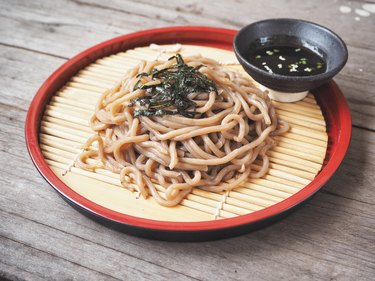
Soba noodles are Japanese noodles that are made from buckwheat flour. The thickness of the noodles is easily comparable to that of spaghetti, and they can be served both hot or cold. Their nutty flavor works well as a base for stir-fries and salads. While soba noodles offer beneficial manganese and fit into calorie-conscious diets, they also have some nutritional drawbacks.
Health Benefits of Soba Noodles
Video of the Day
Buckwheat flour — the base for soba noodles — has many health benefits, as illustrated in many studies shared by the Oldways Whole Grains Council. As a gluten-free grain, it's an alternative for those unable to consume wheat.
Video of the Day
"Buckwheat flour is heart healthy — or protective against heart disease — and rich in phytonutrients," say the co-authors of the book Should I Scoop Out My Bagel?, health and wellness experts Hallie Rich and Ilyse Schapiro, M.D., R.D., CDN. "Phytonutrients are antioxidants that can prevent a variety of diseases."
Rich and Dr. Schapiro explain that buckwheat flour is a good source of nutrients like protein, fiber, iron, carbohydrates and thiamine. Buckwheat noodles are also a great source of manganese. A cup of cooked noodles boasts 426 micrograms, which contributes 19 percent toward the daily manganese needs for men and 24 percent for women.
Manganese makes up a component of several enzymes, including those needed to convert food into energy and antioxidant enzymes — a class of enzymes that quash harmful free radicals to prevent cell damage. Manganese also helps make collagen, a protein required for wound healing, and maintains healthy cartilage and bone.
Buckwheat noodles don't offer a significant amount of any essential vitamin, however, and aside from their manganese content, don't supply much in the way of minerals.
"Some say one-hundred percent buckwheat flour can be as healthy as eating fruits and vegetables," say Rich and Dr. Schapiro. "This doesn't mean you should only consume a diet of buckwheat flour and not to eat fruits and veggies." Learning how to integrate it into your current diet is key to maintain well-rounded nutrition.
Soba Noodles vs. Traditional Pasta
"Soba noodles have less calories more fiber and more protein than traditional pasta, so it won't spike your blood sugar," say Rich and Shapiro. "Traditional pasta, is made out of refined flour and tends to be higher in calories, sugars and carbohydrates."
Soba noodles offer a lower-cal alternative to wheat pasta. Each cup of cooked noodles contains only 113 calories, or just over five percent of the daily limit in a 2,000-calorie diet.
White spaghetti, on the other hand, contains 220 calories per cup, while a whole-wheat version contains 174 calories. If you eat pasta three times per week, switching from white pasta to soba noodles will save you over 16,692 calories annually, or the equivalent of almost five pounds.
Health Drawbacks of Soba Noodles
Soba noodles impact your blood sugar levels because of their glycemic load. A food's glycemic load takes into account its carbohydrate content as well as how quickly the food increases your blood sugar level after you eat it.
Soba noodles have a high glycemic load of 22, which means they can have a significant effect on your blood sugar levels. The Harvard School of Public Health recommends limiting foods with a high glycemic load, and instead opting for lower-GL foods like beans and whole grains, including whole-grain pasta.
When adding soba noodles to your diet — especially if you're gluten-free — it's vital that you look at all of the ingredients. "Don't just assume soba noodles are one-hundred percent buckwheat; many that are sold contain regular flour or half refined flour and half buckwheat flour and you may not be getting the benefits you were hoping for," say Rich and Dr. Schapiro. "So read labels and make sure the first ingredient is buckwheat flour."
If you switch from wheat pasta to soba noodles, you'll miss out on the B-complex vitamins, iron and selenium found in wheat pasta. Pair other ingredients with your buckwheat noodles to prepare meals rich in nutritional value. Top your noodles with chicken breast, shrimp, tofu or tempeh, and add steamed or sauteed vegetables as sources of fiber, vitamin C and antioxidants.